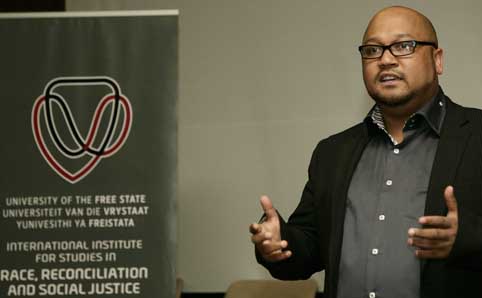 |
|
Eusibius McKaiser
Photo: Johan Roux
9 May 2012
|
Students and staff from our university got the first glimpse of political and social commentator Eusibius McKaiser’s new book, There is a Bantu in my bathroom, during a public lecture of the same title held by the author on the Bloemfontein Campus.
McKaiser told the audience that they were amongst the first people to get a preview of his book, a collection of essays on race, sexuality and politics.
His talk centred on domestic race relationships, posing the question whether it was acceptable to have racial preferences with regard to whom you live with. Recounting an incident he encountered while looking for a flat in Sandton, McKaiser said the country was still many kilometres away from the end-goal of non-racialism.
McKaiser, who hosted a weekly politics and morality show on Talk Radio 702, and is a weekly contributor to The New York Times, said the litmus test for non-racialism in South Africa was not what people utter in a public space, but rather what was said in private.
“We need to talk more about the domestic space. In public, we are very insincere and quick to preach non-racialism.”
Recounting conversations he had with Talk Radio 702 listeners on the incident, McKaiser said that preference about whom you live with was not specific to white people’s attitude. He said many of his black listeners also felt uncomfortable living with a white person. “The question is, ‘What do these preferences say about you? What does it say about where we are as a country and people’s commitment to non-racialism?’”
McKaiser was the guest of the International Institute for Studies in Race, Reconciliation and Social Justice.